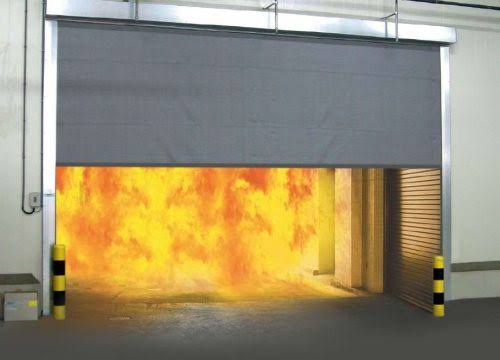Fire curtains are flexible fire-resistant barriers that are built to improve a building’s safety.
They stay hidden inside a head box until they are deployed automatically after a fire alarm or smoke detector activates.
This deployment occurs between guide channels and helps isolate areas inside a building.
The main functions of fire curtains are:
- to contain the fire within a specific area
- to prevent the spread of smoke
- to provide occupants with more time to leave the building safely
Varieties of Fire Curtains
Horizontal Fire Curtains
Horizontal fire curtains spread out horizontally and separate different floors or levels inside of a building.
These are notably useful in keeping the smoke from reaching up to higher levels. Common places where horizontal fire curtains are found are malls, atriums, and large open spaces.
Vertical Fire Curtains
Vertical fire curtains, on the other hand, block off vertical openings like hallways, stairwells, and escalators.
They are barriers that secure escape routes, be they for a commercial building or a residential building.
Perimeter Fire Curtains
As the name suggests, perimeter fire curtains create a boundary around a specific area, isolating it from the rest of the building in case of fire.
Insulated Fire Curtains
Insulated fire curtains feature additional layers of insulation. This shoots up the resistance to heat.
This feature makes them a safer option for evacuation routes.
Uses of Fire Curtains
There are different things in which fire curtains can be helpful:
1. Commercial Spaces: Offices, retail stores, and hotels.
2. Residential Buildings: Apartments and condominiums.
3. Healthcare Facilities: Hospitals and nursing homes.
4. Educational Institutions: Schools and universities.
5. Transportation Hubs: Airports and train stations.
6. Industrial Settings: Warehouses and factories.
Advantages of Fire Curtains
Compartmentalization
The best part about fire curtains is that they divide a building into sections. How is that helpful? By stopping the spread of fire and smoke from spreading into other sections like escape routes.
Design Flexibility
With fire curtains, architects can design more open and adaptable spaces. They have more flexibility compared to traditional fire-rated walls or doors. So, a building can have larger and unobstructed areas and still be safe.
Space Efficiency
When not in use, fire curtains are compact and unobtrusive. They take up very little space and are proper for areas with limited space.
Cost-Effectiveness
Compared to other methods, fire curtains are more affordable as a fire protection solution. This is particularly so in large open spaces where traditional options may be impractical or too expensive.
Aesthetic Appeal
Fire curtains are designed to go well with different building interiors. When they’re not deployed, they’re not easily seen, so they don’t hurt the design theme of the space.
Installation and Upkeep
Proper installation and regular maintenance are essential to ensure that your fire curtains will function correctly during a fire.
Only trained professionals, those who can strictly adhere to manufacturers’ guidelines and local building codes, should be hired to install fire curtains.
Fire safety measures must take issues like obstructions or damage very seriously. Regular inspections and testing of fire curtains, as well as their maintenance, can identify potential issues well in time, keeping them reliable.
Companies interested in installing fire curtains on their property should only consult with reputable companies. By doing so, they can be sure that they will fulfill both safety and design requirements.
For over 33 years, the A1S Group has been renowned for manufacturing and installing fire curtains, smoke curtains, fire shutters, and roller shutters. They observe safety standards to provide innovative and aesthetically pleasing fire safety solutions, which makes them a trusted name in the industry.

